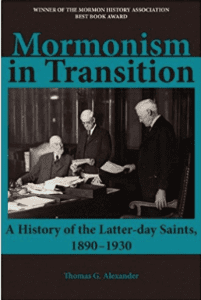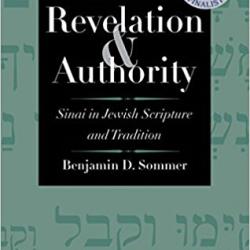 What do I mean by “transitional Mormonism”? (Part 1 is here if you missed it.) I take the idea from the title of Thomas Alexander’s award-winning book Mormonism in Transition: A History of the Latter-day Saints, 1890-1930, now in a 3rd edition. Alexander was a BYU professor, and wrote this as part of a commissioned 16-volume history of the Church that did not come to fruition. This time period was a particularly tumultuous one both for the LDS Church and America, with major intellectual, social, scientific, and technological changes. Among other things, the “modernism crisis” with Darwinism/evolution, “higher criticism,” and the rediscovery of the ancient near east led to the creation of fundamentalism (an intellectual response to the crisis) as well as Pentecostalism (a spiritual response.)
What do I mean by “transitional Mormonism”? (Part 1 is here if you missed it.) I take the idea from the title of Thomas Alexander’s award-winning book Mormonism in Transition: A History of the Latter-day Saints, 1890-1930, now in a 3rd edition. Alexander was a BYU professor, and wrote this as part of a commissioned 16-volume history of the Church that did not come to fruition. This time period was a particularly tumultuous one both for the LDS Church and America, with major intellectual, social, scientific, and technological changes. Among other things, the “modernism crisis” with Darwinism/evolution, “higher criticism,” and the rediscovery of the ancient near east led to the creation of fundamentalism (an intellectual response to the crisis) as well as Pentecostalism (a spiritual response.)
The LDS Church existed in the same environment, and many major changes to policy, doctrinal understanding, and LDS culture happened during this period Alexander chronicles. These changes discomfitted many LDS, who reacted in a variety of ways including both intellectual and actual schisms. For those not well acquainted with LDS history, I would characterize this period as the bridge between “Joseph Smith’s church” and the “modern church.”
What are these discomfitting changes? To pick a few major ones Alexander covers well and hold my interest
- The ending of (mainstream) lived polygamy
- The beginning of geneaological research and the associated centrality of the temple. That is, until this time, it seems the importance of learning about your ancestors and doing their temple work and sealing was not understood; consequently, most Mormons (including Apostles) were endowed, married, and then didn’t have any theological motivation to return. Once Wilford Woodruff put an end to the idea of “adoption” and emphasized geneaology, the need to attend to proxy ordinances greatly increased.
- The codification/standardizing of the Word of Wisdom and its elevation to a temple recommend question. Among others, see Mike Ash “Up in Smoke” and Edward L. Kimball, “The History of LDS Temple Admission Standards”
- Doctrinal regulation/centralization
I suspect Mormonism has now entered a similar transitionary period as the one Alexander describes from 100 years ago. Certainly, Mormonism is always changing in some way or another so in a later post I’ll explain why I think we’re into another major transitionary period and why. I’ll also describe a parallel transition that I suspect is informing LDS leadership. In the meantime, check out Alexander’s book.
As always, you can help me pay my tuition here, or you can support my work through making your regular Amazon purchases through this Amazon link. You can also get updates by email whenever a post goes up (subscription box on the right). If you friend me on Facebook, please drop me a note telling me you’re a reader. I tend not to accept friend requests from people I’m not acquainted with.










